The Gospel of Peter is a pseudepigraphal (noncanonical and unauthentic) manuscript that claims to be written by the Apostle Peter. The earliest surviving manuscript dates from the 8th or 9th century. It contains 60 verses and covers events at the end of Jesus’ life. However, the original is thought to have been written c. AD 150, meaning it could not have been written by the apostle Peter and the canon of the New Testament was reserved only for those writings that were either written by an apostle or an associate of an apostle.
The Gospel of Peter describes the events surrounding the end of Jesus’ life, including his trial, crucifixion, burial, and resurrection. The account of the crucifixion seems to carefully avoid saying that Jesus died, asserting instead that He “was taken up” at the moment His divine power left His bodily shell, which had only been a temporary residence. It also claims that Jesus “remained silent, as though he felt no pain” on the cross. Both of these highlight the error of Docetism.
One of the ways the Gospel of Peter differs from the Gospels of Matthew, Mark, Luke, and John is the description of events after Jesus’ body was laid in the tomb. The Gospel of Peter says that the guards “saw the heavens opened, and two men descend with a great light and approach the tomb. . . . Again, they saw three men come forth from the tomb, and two of them supporting one, and a cross following them. And the heads of the two indeed reached up to the heaven, but that of him that was led by their hands rose above the heavens. And they heard a voice from the heavens, saying, ‘You have preached to them that sleep.’ And a response was heard from the cross, ‘Yes.’”
The Gospel of Peter was allegedly discovered in 1886-1887 during excavations in Akhmîm, Upper Egypt. A ninth-century manuscript was found in a monk’s coffin, now known as the Akhmîm fragment. Before the discovery, scholars knew very little about the Gospel of Peter. Their first main source was Eusebius of Caesarea (c. A.D. 260-340), the well-known early church historian, who noted that the Gospel of Peter was among the church’s rejected writings and had heretical roots. This is what he wrote:
The so-called Acts of Peter, however, and the Gospel which bears his name, and the Preaching and the Apocalypse, as they are called, we know have not been universally accepted, because no ecclesiastical writer, ancient or modern, has made use of testimonies drawn from them. (Eusebius, Church History, Book 3, Chapter 3, Paragraph 2) …we have felt compelled to give this catalogue in order that we might be able to know both these works and those that are cited by the heretics under the name of the apostles, including, for instance, such books as the Gospels of Peter … which no one belonging to the succession of ecclesiastical writers has deemed worthy of mention in his writings. (Eusebius, Church History, Book 3, Chapter 25, Paragraph 6)
The second main source for the Gospel of Peter is a letter by Bishop Serapion of Antioch (c. AD 200), titled “Concerning What is Known as the Gospel of Peter.” (Bishop Serapion’s letter is preserved by Eusebius in his Ecclesiastical History 6.12.3-6). He advised church leaders not to read the so-called Gospel of Peter to their congregations because of its Docetic content. He also condemned it as a forgery. Docetism is a Christian heresy affirming that Christ did not have a real or natural body during his life on earth but only an apparent or phantom one. This is what the bishop wrote:
For we, brethren, receive both Peter and the other apostles as Christ; but we reject intelligently the writings falsely ascribed to them, knowing that such were not handed down to us. … For having obtained this Gospel from others who had studied it diligently, namely, from the successors of those who first used it, whom we call Docetæ (for most of their opinions are connected with the teaching of that school ) we have been able to read it through, and we find many things in accordance with the true doctrine of the Saviour, but some things added to that doctrine, which we have pointed out for you farther on. (Eusebius, Church History, Book 6, Chapter 12, Paragraphs 3 & 6)
Most scholars would not date this Gospel before 130-150 AD because of (1) the numerous historical errors, including a multitude of legendary embellishments and lack of first-century historical knowledge, and (2) the likely dependence that the Gospel of Peter has on the New Testament Gospels. For these reasons, among many, most scholars today reject the Gospel of Peter as giving us as accurate a portrait of Jesus as the standard New Testament Gospels and regard it as a late composition from the second century, meaning the Apostle Peter could not have been its actual author, making it a forgery. Thus, it could not be accepted into the canon of the New Testament.
References:
https://carm.org/lost-books/does-the-gospel-of-peter-belong-in-the-new-testament/
https://www.britannica.com/topic/Docetism
https://www.gotquestions.org/gospel-of-Peter.html
For more articles like this, click here.



